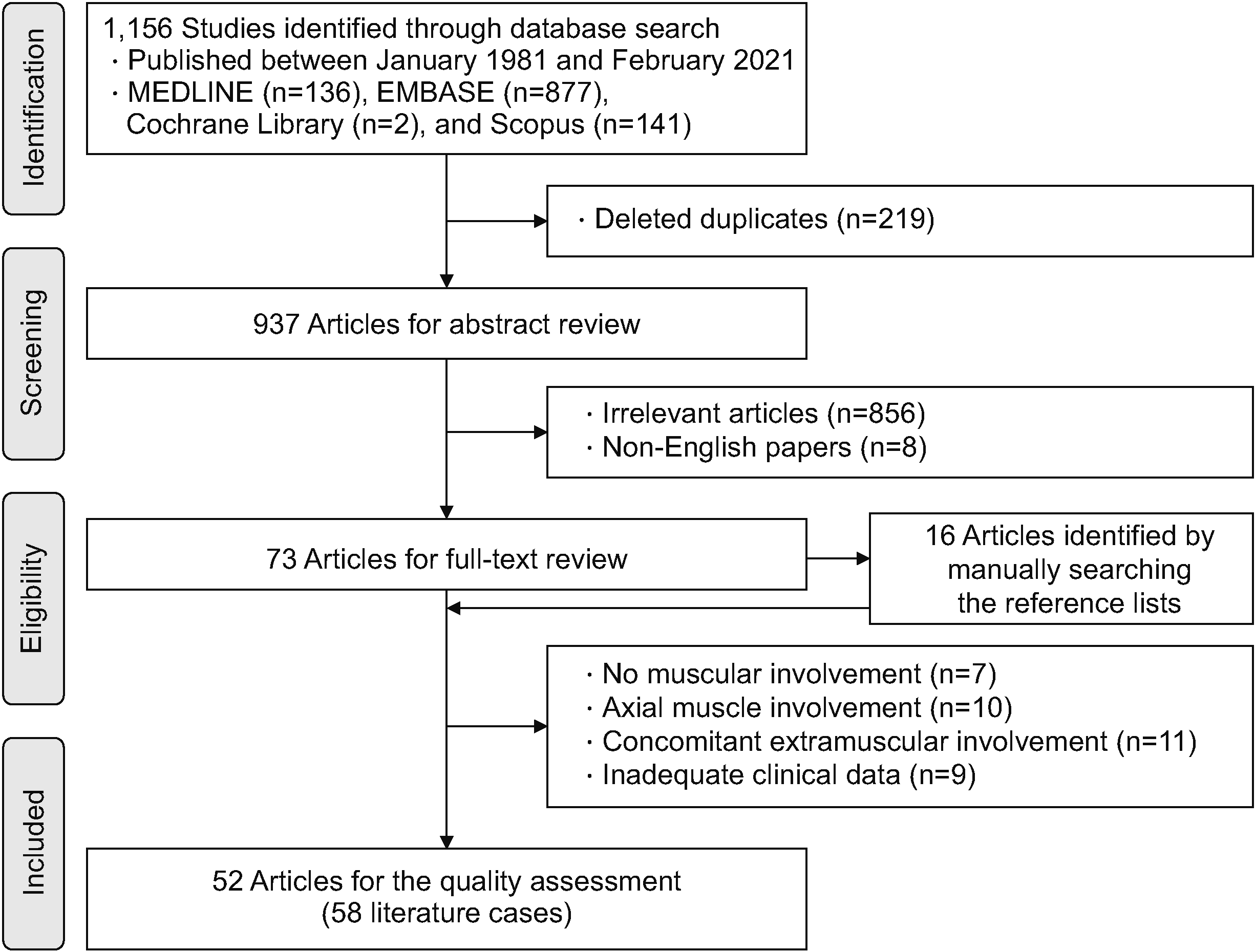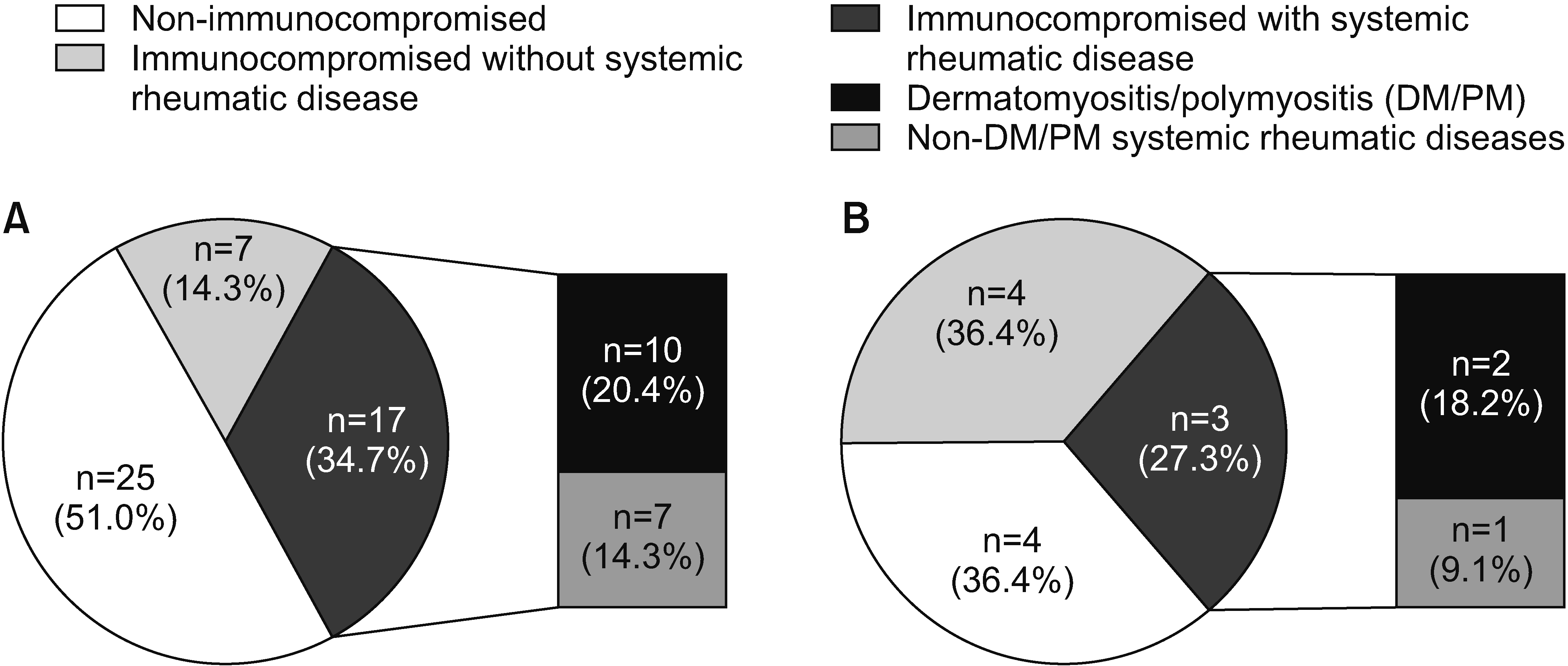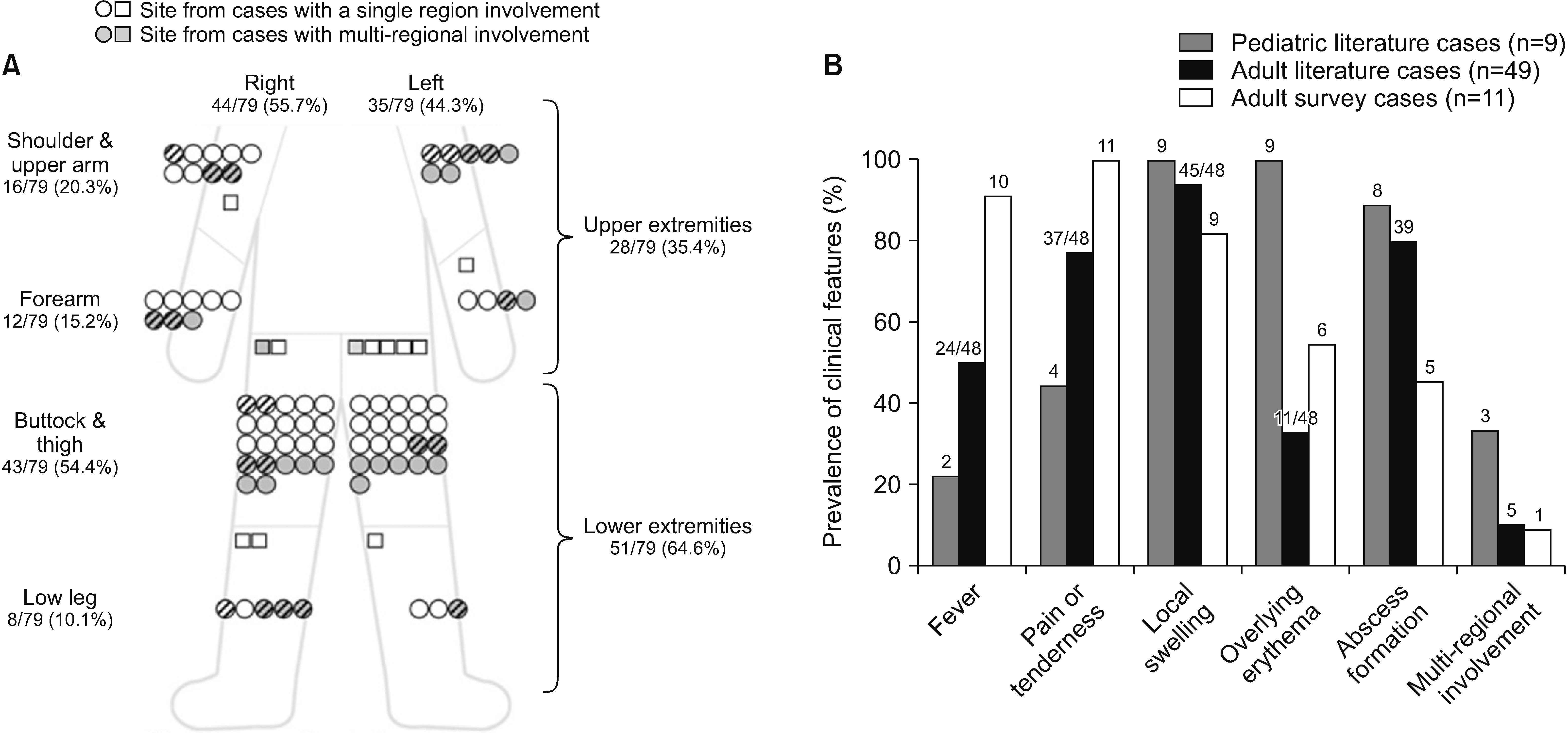1. Cambau E, Drancourt M. 2014; Steps towards the discovery of Mycobacterium tuberculosis by Robert Koch, 1882. Clin Microbiol Infect. 20:196–201. DOI:
10.1111/1469-0691.12555. PMID:
24450600.

3. Raut AA, Naphade PS, Ramakantan R. 2016; Imaging spectrum of extrathoracic tuberculosis. Radiol Clin North Am. 54:475–501. DOI:
10.1016/j.rcl.2015.12.013. PMID:
27153784.

4. Plummer WW, Sanes S, Smith WS. 1934; Hematogenous tuberculosis of skeletal muscle: report of a case with involvement of the gastrocnemius muscle. J Bone Joint Surg. 16:631–9.
5. Wang JY, Lee LN, Hsueh PR, Shih JY, Chang YL, Yang PC, et al. 2003; Tuberculous myositis: a rare but existing clinical entity. Rheumatology (Oxford). 42:836–40. DOI:
10.1093/rheumatology/keg228R.

6. Zeng Y, Liu Y, Xie Y, Liang J, Kuang J, Lu Z, et al. 2019; Muscular tuberculosis: a new case and a review of the literature. Front Neurol. 10:1031. DOI:
10.3389/fneur.2019.01031. PMID:
31632334. PMCID:
PMC6779781.

7. Singh H, Kopp C, Sharma A, Sharma S, Naidu S, Jain S, et al. 2022; Primary tuberculous myositis-report of a case and systematic review of literature in the last 25 years. J Clin Rheumatol. 28:e278–81. DOI:
10.1097/RHU.0000000000001668. PMID:
33323750.

8. World Health Organization. c2013. Definitions and reporting framework for tuberculosis - 2013 revision: updated December 2014 and January 2020 [Internet]. World Health Organization;Geneva:
https://apps.who.int/iris/handle/10665/79199. cited 2021 Aug 23.
11. Targeted tuberculin testing and treatment of latent tuberculosis infection. 2000; Targeted tuberculin testing and treatment of latent tuberculosis infection. American Thoracic Society. MMWR Recomm Rep. 49(RR-6):1–51.
13. del Giglio A, Pinczowski H, Portugal G, Feher O. 1997; Tuberculous skeletal muscle involvement in acute leukemia: report on two cases. Tumori. 83:618–20. DOI:
10.1177/030089169708300229. PMID:
9226033.

14. Abdelwahab IF, Kenan S. 1998; Tuberculous abscess of the brachialis and biceps brachii muscles without osseous involvement. A case report. J Bone Joint Surg Am. 80:1521–4. DOI:
10.2106/00004623-199810000-00014. PMID:
9801221.

15. Toda K, Yasunaga Y, Takemoto S, Terada Y. 1998; MR image and CT scan of a tuberculous abscess in the gluteus maximus muscle. Comput Med Imaging Graph. 22:425–7. DOI:
10.1016/S0895-6111(98)00046-9.

16. Huang KL, Chang DM, Lu JJ. 1999; Tuberculosis of skeletal muscle in a case of polymyositis. Scand J Rheumatol. 28:380–2. DOI:
10.1080/03009749950155391. PMID:
10665746.
17. Learch TJ, Hsiao NM. 1999; Tuberculous infection of the gracilis muscle and tendon clinically mimicking deep venous thrombosis: sonographic findings. Skeletal Radiol. 28:457–9. DOI:
10.1007/s002560050546. PMID:
10486015.

18. Abu-Salem OT. 2000; Tuberculous abscesses of the quadriceps femoris muscle without osseous involvement. East Mediterr Health J. 6:1136–8. DOI:
10.26719/2000.6.5-6.1136. PMID:
12197341.

19. Johnson DW, Herzig KA. 2000; Isolated tuberculous pyomyositis in a renal transplant patient. Nephrol Dial Transplant. 15:743. DOI:
10.1093/ndt/15.5.743. PMID:
10809836.

20. Ergin F, Arslan H, Bilezikçi B, Ağildere AM, Ozdemir N. 2001; Primary tuberculosis in the gluteal muscle of a patient with chronic renal failure. A rare presentation. Nephron. 89:463–6. DOI:
10.1159/000046122. PMID:
11721168.

22. Trikha V, Gupta V. 2002; Isolated tuberculous abscess in biceps brachii muscle of a young male. J Infect. 44:265–6. DOI:
10.1053/jinf.2002.0986. PMID:
12099736.

24. Mootsikapun P, Mahakkanukrauh A, Suwannaroj S, Nanagara R. 2003; Tuberculous pyomyositis. J Med Assoc Thai. 86:477–81.
26. Walji S, Rubenstein J, Shannon P, Carette S. 2005; Disseminated pyomyositis mimicking idiopathic inflammatory myopathy. J Rheumatol. 32:184–7.
27. Trikha V, Varshney MK, Rastogi S. 2006; Isolated tuberculosis of the vastus lateralis muscle: a case report. Scand J Infect Dis. 38:304–6. DOI:
10.1080/00365540500353267. PMID:
16718935.

28. Batra S, Ab Naell M, Barwick C, Kanvinde R. 2007; Tuberculous pyomyositis of the thigh masquerading as malignancy with concomitant tuberculous flexor tenosynovitis and dactylitis of the hand. Singapore Med J. 48:1042–6.
29. Liu CH, Liu WC, Chen LW, Chen JS. 2008; Tuberculous myofasciitis in dermatomyositis. Clin Rheumatol. 27 Suppl 1:S7–9. DOI:
10.1007/s10067-007-0799-3. PMID:
18224367.

30. Chen YC, Sheen JM, Huang LT, Wu KS, Hsiao CC. 2009; Disseminated tuberculous myositis in a child with acute myelogenous leukemia. Pediatr Neonatol. 50:74–7. DOI:
10.1016/S1875-9572(09)60037-1.

31. Chen WL, Lin YF, Tsai WC, Tsao YT. 2009; Unveiling tuberculous pyomyositis: an emerging role of immune reconstitution inflammatory syndrome. Am J Emerg Med. 27:251.e1–2. DOI:
10.1016/j.ajem.2008.05.030. PMID:
19371548.

33. Sabat D, Kumar V. 2009; Primary tuberculous abscess of rectus femoris muscle: a case report. J Infect Dev Ctries. 3:476–8. DOI:
10.3855/jidc.421. PMID:
19762963.

34. Gayathri Devi DR, Gowri M, Padmalatha S, Sreeja S, Babu S. 2010; Atypical presentation of Mycobacterium tuberculosis in an infant. Indian J Pediatr. 77:1440–2. DOI:
10.1007/s12098-010-0238-3. PMID:
20890682.

35. Huang CC, Liu MF, Lee NY, Chang CM, Lee HC, Wu CJ, et al. 2010; Fatal tuberculous myositis in an immunocompromised adult with primary Sjögren's syndrome. J Formos Med Assoc. 109:680–3. DOI:
10.1016/S0929-6646(10)60110-6.

36. Khosla P, Aroaa N, Jain S. 2010; Tubercular pyomyositis in a case of rheumatoid arthritis being treated with infliximab. Int J Rheum Dis. 13:82–5. DOI:
10.1111/j.1756-185X.2009.01445.x. PMID:
20374389.

37. Neogi DS, Jain S, Mishra KK, Trikha V, Nag HL. 2010; An unusual cause of Wartenberg's syndrome: tuberculosis of brachioradialis muscle. Eur J Orthop Surg Traumatol. 20:335–8. DOI:
10.1007/s00590-009-0569-9.

38. Sen RK, Tripathy SK, Dhatt S, Saini R, Aggarwal S, Agarwal A. 2010; Primary tuberculous pyomyositis of forearm muscles. Indian J Tuberc. 57:34–40.
39. Sokolove J, Copland A, Shirvani S, Brown J, Posley K, Chung L. 2010; A 39-year-old woman with lupus, myositis, and a recalcitrant vasculopathy. Arthritis Care Res (Hoboken). 62:1351–6. DOI:
10.1002/acr.20236. PMID:
20506174.

40. Jois R, Vasudevan N, Srinivasan P, Mehta R. 2011; Resistant dermatomyositis complicated by tubercular myositis and successfully treated with rituximab. Neurol India. 59:306–7. DOI:
10.4103/0028-3886.79163. PMID:
21483146.

41. Perez-Alonso AJ, Husein-ElAhmed H, Duran CP, Caballero-Marcos L, Ramon JAP. 2011; Isolated muscle tuberculosis. Med Mal Infect. 41:559–60. DOI:
10.1016/j.medmal.2011.05.002. PMID:
21775084.

42. Sen RK, Triapathy SK, Deivaraju C, Das A. 2011; Isolated focal pyomyositis of teres minor: an unusual presentation of tuberculosis. Acta Orthop Traumatol Turc. 45:276–9. DOI:
10.3944/AOTT.2011.2447. PMID:
21908969.

43. Simon SP, Fodor D, Valasciuc R, Tamas MM, Rednic S. 2011; A rare case of primary tuberculous pyomyositis. Case report. Med Ultrason. 13:245–8.
44. Arora S, Sabat D, Sural S, Dhal A. 2012; Isolated tuberculous pyomyositis of semimembranosus and adductor magnus: a case report. Orthop Surg. 4:266–8. DOI:
10.1111/os.12011. PMID:
23109314. PMCID:
PMC6583273.

46. Neild GH, Hughes TD, Booth JW, Wheeler DC. 2012; Tuberculous pyomyositis in a renal transplant recipient. Clin Kidney J. 5:367–8. DOI:
10.1093/ckj/sfs075. PMID:
25874103. PMCID:
PMC4393480.

47. De C, Mondal BC, Sinha RK, Dasgupta S, Ghosh D, Majhi A. 2013; A case series of 21 patients with non-osteo-articular tuberculosis of limbs. Int Musculoskelet Med. 35:12–8. DOI:
10.1179/1753615413Y.0000000016.

48. Kulkarni SA, Patil SS, Kulkarni P, Udgaonkar US, Gadgil SA. 2013; Primary tuberculous myositis: a rare clinical entity. Indian J Tuberc. 60:241–4.
49. Modi MA, Mate AD, Nasta AM, Gvalani AK. 2013; Primary tuberculous pyomyositis of quadriceps femoris in an immunocompetent individual. Case Rep Infect Dis. 2013:723879. DOI:
10.1155/2013/723879. PMID:
24367732. PMCID:
PMC3866826.

50. Neogi DS, Bandekar SM, Chawla L. 2013; Skeletal muscle tuberculosis simultaneously involving multiple sites. J Pediatr Orthop B. 22:167–9. DOI:
10.1097/BPB.0b013e328354b04d. PMID:
22561909.

51. Sökücü S, Sökücü SN, Kabukçuoglu Y, Kabukçuoglu F. 2013; Primary skeletal muscle tuberculosis at an unusual site. J Pak Med Assoc. 63:126–8.
53. Wisanuyotin T, Sirichativapee W, Sumnanoont C, Paholpak P, Koonmee S, Laupattarakasem P, et al. 2014; Fatal peripheral T-cell lymphoma following intramuscular tuberculosis of the forearm. Southeast Asian J Trop Med Public Health. 45:1119–24.
54. Dhakal AK, Shah SC, Shrestha D, Banepali N, Geetika KC. 2015; Tuberculosis presenting as multiple intramuscular nodules in a child: a case report. J Med Case Rep. 9:72. DOI:
10.1186/s13256-015-0543-6. PMID:
25885776. PMCID:
PMC4381512.

57. Simopoulou T, Varna A, Dailiana Z, Katsiari C, Alexiou I, Basdekis G, et al. 2016; Tuberculous pyomyositis: a re-emerging entity of many faces. Clin Rheumatol. 35:1105–10. DOI:
10.1007/s10067-014-2564-8. PMID:
24609759.

58. Akselrod H, Modak RM, Cushing L, Seemungal I, Simon GL. 2017; Difficult to discern: tuberculous myositis with Poncet's arthritis. Am J Med. 130:1376–8. DOI:
10.1016/j.amjmed.2017.08.001. PMID:
28821375.

60. Al-Khazraji A, Takher J, Alkhawam H, Fabbri M. 2017; Primary tuberculous pyomyositis of the calf muscles. Am J Med Sci. 353:187–8. DOI:
10.1016/j.amjms.2016.05.010. PMID:
28183421.

61. Daboussi S, M'hamdi S, Aichaouia C, Moatamri Z, Khadraoui M, Cheikh R. 2017; Primary skeletal muscle tuberculosis in an immunocompetent patient. Clin Pract (Lond). 14:244–7. DOI:
10.4172/clinical-practice.1000119.

62. Gao W, Zeng Y, Chen W. 2020; Multiple subcutaneous tuberculous abscesses in a dermatomyositis patient without pulmonary tuberculosis: a case report and literature review. BMC Infect Dis. 20:409. DOI:
10.1186/s12879-020-05137-w. PMID:
32532200. PMCID:
PMC7291664.

65. Johansen IS, Nielsen SL, Hove M, Kehrer M, Shakar S, Wøyen AVT, et al. 2015; Characteristics and clinical outcome of bone and joint tuberculosis from 1994 to 2011: a retrospective register-based study in Denmark. Clin Infect Dis. 61:554–62. DOI:
10.1093/cid/civ326. PMID:
25908683.

66. Shi T, Zhang Z, Dai F, Zhou Q, He Q, Luo F, et al. 2016; Retrospective study of 967 patients with spinal tuberculosis. Orthopedics. 39:e838–43. DOI:
10.3928/01477447-20160509-03. PMID:
27172367.

67. Aaron L, Saadoun D, Calatroni I, Launay O, Mémain N, Vincent V, et al. 2004; Tuberculosis in HIV-infected patients: a comprehensive review. Clin Microbiol Infect. 10:388–98. DOI:
10.1111/j.1469-0691.2004.00758.x. PMID:
15113314.

68. Leeds IL, Magee MJ, Kurbatova EV, del Rio C, Blumberg HM, Leonard MK, et al. 2012; Site of extrapulmonary tuberculosis is associated with HIV infection. Clin Infect Dis. 55:75–81. DOI:
10.1093/cid/cis303. PMID:
22423123. PMCID:
PMC3493181.

69. Zürcher K, Ballif M, Kiertiburanakul S, Chenal H, Yotebieng M, Grinsztejn B, et al. 2019; Diagnosis and clinical outcomes of extrapulmonary tuberculosis in antiretroviral therapy programmes in low- and middle-income countries: a multicohort study. J Int AIDS Soc. 22:e25392.
70. Gräb J, Suárez I, van Gumpel E, Winter S, Schreiber F, Esser A, et al. 2019; Corticosteroids inhibit Mycobacterium tuberculosis-induced necrotic host cell death by abrogating mitochondrial membrane permeability transition. Nat Commun. 10:688. DOI:
10.1038/s41467-019-08405-9. PMID:
30737374. PMCID:
PMC6368550.

71. Marie I, Ménard JF, Hachulla E, Chérin P, Benveniste O, Tiev K, et al. 2011; Infectious complications in polymyositis and dermatomyositis: a series of 279 patients. Semin Arthritis Rheum. 41:48–60. DOI:
10.1016/j.semarthrit.2010.08.003. PMID:
21047670.

72. Murray SG, Schmajuk G, Trupin L, Lawson E, Cascino M, Barton J, et al. 2015; A population-based study of infection-related hospital mortality in patients with dermatomyositis/polymyositis. Arthritis Care Res (Hoboken). 67:673–80. DOI:
10.1002/acr.22501. PMID:
25331828. PMCID:
PMC4404175.

73. Hsu CY, Ko CH, Wang JL, Hsu TC, Lin CY. 2019; Comparing the burdens of opportunistic infections among patients with systemic rheumatic diseases: a nationally representative cohort study. Arthritis Res Ther. 21:211. DOI:
10.1186/s13075-019-1997-5. PMID:
31604447. PMCID:
PMC6790041.

74. Ramagopalan SV, Goldacre R, Skingsley A, Conlon C, Goldacre MJ. 2013; Associations between selected immune-mediated diseases and tuberculosis: record-linkage studies. BMC Med. 11:97. DOI:
10.1186/1741-7015-11-97. PMID:
23557090. PMCID:
PMC3616814.

75. Robach P, Cairo G, Gelfi C, Bernuzzi F, Pilegaard H, Viganò A, et al. 2007; Strong iron demand during hypoxia-induced erythropoiesis is associated with down-regulation of iron-related proteins and myoglobin in human skeletal muscle. Blood. 109:4724–31. DOI:
10.1182/blood-2006-08-040006. PMID:
17311997.

76. Raghu B, Sarma GR, Venkatesan P. 1993; Effect of iron on the growth and siderophore production of mycobacteria. Biochem Mol Biol Int. 31:341–8.
77. Cronjé L, Edmondson N, Eisenach KD, Bornman L. 2005; Iron and iron chelating agents modulate Mycobacterium tuberculosis growth and monocyte-macrophage viability and effector functions. FEMS Immunol Med Microbiol. 45:103–12. DOI:
10.1016/j.femsim.2005.02.007. PMID:
16051061.
78. Lai CC, Lee MT, Lee SH, Lee SH, Chang SS, Lee CC. 2015; Risk of incident active tuberculosis and use of corticosteroids. Int J Tuberc Lung Dis. 19:936–42. DOI:
10.5588/ijtld.15.0031. PMID:
26162360.








 PDF
PDF Citation
Citation Print
Print



 XML Download
XML Download